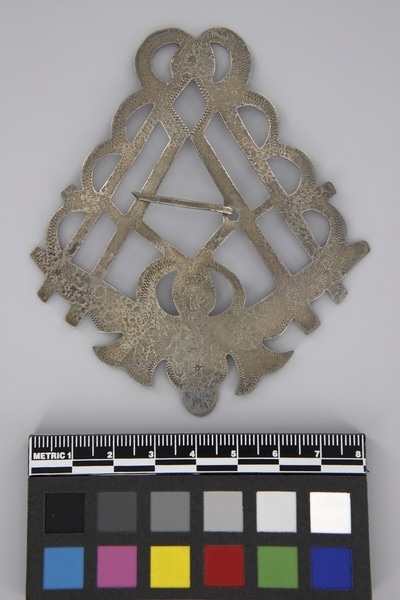Brooch Item Number: 1590/102 from the MOA: University of British Columbia

Description
Triangular Masonic-style brooch with irregular edge. 18 cutouts, of which 10 are semi-circular, 6 rectangular and 2 diamond-shaped. Engraved with 6 stars and zigzag border. Outer edge of left and right side scalloped. Base has two bell-shaped protrusions. Cross-pin attached. Maker’s marks on front.
History Of Use
Silver ornaments represent an important part of early exchange between Europeans, including fur traders, and First Nations people, especially in eastern and central Canada and the USA. Initially, the main source of silver was British, French and Spanish coins. Most ornaments were produced by silversmiths of European origin in North America and Europe, and were actively traded only from 1760 to 1821. By the mid-18th century silver objects were produced in New England, Quebec and Montreal. Silver was used by First Nations people as a sign of rank. Silver ornaments in these styles continue to be produced by native silversmiths in central Canada and the USA. Brooches were the most popular and numerous silver ornaments. They were worn on the chest, but also in the hair. Frequently, many were worn at once in rows across the chest. Windsor dealt with the XY Company. In 1798, a group of Montreal traders formed the New North West company to compete with the North West Company (NWC). The former was dubbed the XY Company after the insignia on its kegs and bales of furs. When former NWC partner, Alexander Mackenzie, joined the XY Company, the name was changed to Alexander Mackenzie and Company. In 1804 the two companies merged under the NorthWest Company name. Newman, Peter Co. "Empire of the Bay", Viking 1985.
Specific Techniques
Rocker engraving is a freehand technique which produces uneven zigzagging.
Cultural Context
trade: personal decoration; status
Iconographic Meaning
Masonic emblem of compass and square adopted by the Iroquois to represent the “Council fire”, a meeting of chiefs. The Freemasons' symbols are plumb, compass, square, level. The Masonic-type brooch may have been introduced by Mohawk Chief, Joseph Brant, who in 1775 became a member of the Masonic Order in London.
Item History
- Made by David Windsor (Manufacturer) in Canada between 1760 and 1821
- Owned by Kathleen E. Reif before September 9, 1993
- Received from Kathleen E. Reif (Donor) on September 9, 1993
What
Who
- Culture
- Eastern Woodlands
- Creator
- David Windsor (Manufacturer)
- Previous Owner
- Kathleen E. Reif
- Received from
- Kathleen E. Reif (Donor)
Where
- Holding Institution
- MOA: University of British Columbia
- Made in
- Canada
When
- Creation Date
- between 1760 and 1821
- Ownership Date
- before September 9, 1993
- Acquisition Date
- on September 9, 1993
Other
- Item Classes
- metalwork
- Condition
- good
- Current Location
- Case 45
- Accession Number
- 1590/0102